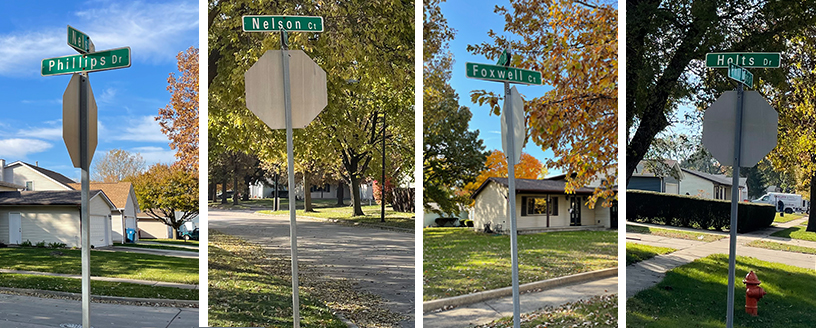Dr. Martin Luther King Subdivision
Between N. Fourth Street and the Canadian National Railroad Tracks
The Dr. Martin Luther King Subdivision, located between North Fourth Street and the Canadian National railroad tracks in Champaign, Illinois, was a part of urban renewal that took place in the late 1960s, eventually replacing the old Oak-Ash neighborhood. It began in the 1980s and was the only urban renewal project that was not replaced with public or subsidized housing. The names of the streets in the subdivision were chosen to recognize African Americans who were historically significant for the community and submitted to the city council by J. W. Pirtle.
Charles E. Phillips (1889-1975) was a grandson of David Johnson, a formerly enslaved person, who came to Champaign-Urbana after the Civil War and was one of the founders of the Second Baptist Church, now Salem Baptist, in Champaign. Deeply involved in community activities, Mr. Phillips was a forerunner in promoting low cost, affordable housing for African Americans in the community. He served as a scoutmaster with Boy Scout Troop 11 through the Arrowhead Council for 25 years. He was appointed a member of the Champaign Housing Commission and served as honorary Vice President of the Champaign County Urban League. He also served on the board of the Francis Nelson Health Center.
Alvin G. Foxwell (1896-1959) was one of the charter members of the William F. Earnest American Legion Post 559 and an active member of the community. He was a member and Trustee of Salem Baptist Church. He was active with the Republican Party and the Champaign Recreation Department, where he was one of the originators of the Servicemen’s Organization that lobbied for the establishment of a Servicemen’s Center for Black soldiers who were segregated from the recreational facilities at Chanute Field in Rantoul, Illinois, and for Douglass Center.
Cecil Dewey Nelson (1898-1971) was a charter and lifetime member of the William F. Earnest American Legion Post 559 where he served as its Commander. He also served as a Legion officer at both the state and national levels. A decorated sergeant in the all-Black 370th Infantry Regiment in World War I, Mr. Nelson was a recipient of the French Croix de Guerre for bravery in battle and a Purple Heart. A former member of the Champaign Recreation Department, during World War II he was one of the organizers of the Servicemen’s Center, created to provide a recreational space for Black soldiers and the establishment of Douglass Park and Center. He served as a scoutmaster with Boy Scout Troop 11. He was a member of Bethel A.M.E. Church, where he served on the Trustee Board and the Lone Star Lodge #18, Prince Hall Masons.
Willie Holt (1900-1985) was a small businessman in Champaign-Urbana’s African American community who operated a sanitary hauling business for over 20 years. Born in Paris, Tennessee, on December 25, 1900, his family were primarily farmers. He moved to Champaign in 1921 where he and his wife, Effie, raised their five children. For many years he worked for the Clifford-Jacob forging plant. In 1940, Mr. Holt went into business for himself, retiring in the mid-1960s. He was active in the community, serving as an ordained deacon at Salem Baptist Church and was a member and past treasurer of the University Elks Lodge 619.
Decade:
1960-1969
People:
- Alvin G. Foxwell
- Cecil Dewey Nelson
- Charles E. Phillips
- Willie Holt
Location(s):
- Champaign, Illinois
Additional Champaign Trail Sites

